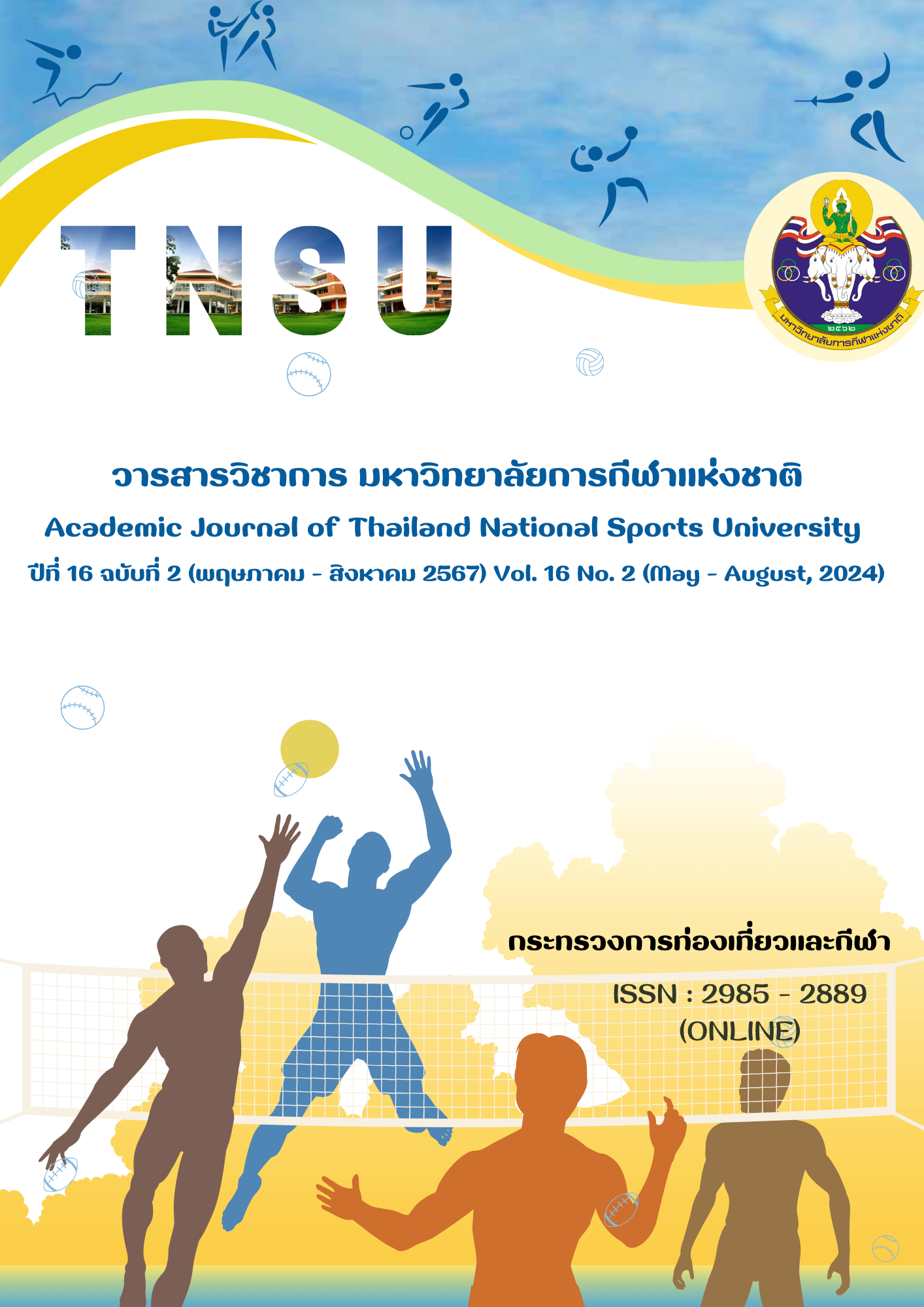ผลของการออกกำลังกายเพื่อสุขภาพในยุคชีวิตวิถีใหม่
Main Article Content
บทคัดย่อ
การวิจัยครั้งนี้เป็นการวิจัยแบบกึ่งทดลอง มีวัตถุประสงค์เพื่อเปรียบเทียบสมรรถภาพทางกายก่อนและหลังการเข้าร่วมโปรแกรมการออกกำลังกายเพื่อสุขภาพในยุคชีวิตวิถีใหม่ กลุ่มตัวอย่างที่ใช้ คือบุคลากรทางการศึกษา เพศหญิง ในมหาวิทยาลัยการกีฬาแห่งชาติ วิทยาเขตเชียงใหม่ จำนวน 30 คน คัดเลือกแบบหลายขั้นตอน เครื่องมือที่ใช้ในการวิจัย ได้แก่ โปรแกรมการออกกำลังกายเพื่อสุขภาพในยุคชีวิตวิถีใหม่ ระยะเวลา 8 สัปดาห์ ประเมินสมรรถภาพทางกายเพื่อสุขภาพ ก่อนเริ่มโปรแกรม และหลังใช้โปรแกรม 4 และ 8 สัปดาห์ วิเคราะห์ข้อมูลโดยใช้สถิติการวิเคราะห์ความแปรปรวนทางเดียวแบบวัดซ้ำ ผลการวิจัยปรากฏว่า กลุ่มตัวอย่างมีอายุเฉลี่ย 36.13 ± 9.09 ปี กิจกรรมทางกายเฉลี่ย 359.17 ± 192.33 นาทีต่อสัปดาห์ หรือคิดเป็น 1,425.85 ± 751.99 MET นาทีต่อสัปดาห์ มีพฤติกรรมเนือยนิ่ง เฉลี่ย 397.33 ± 241.08 นาทีต่อวัน หลังจากเข้าร่วมโปรแกรม 4 สัปดาห์ มีการเปลี่ยนแปลงอย่างมีนัยสำคัญทางสถิติ โดยความทนต่อระบบหัวใจและหลอดเลือด ความแข็งแรงของกล้ามเนื้อขา และความแข็งแรงกล้ามเนื้อแขนเพิ่มขึ้น (p < 0.001) ค่าดัชนีมวลกายลดลง (p < 0.001) แต่ความอ่อนตัวไม่มีความแตกต่าง (p = 0.108) หลังจากเข้าร่วมโปรแกรม 8 สัปดาห์ มีการเปลี่ยนแปลงอย่างมีนัยสำคัญทางสถิติ โดยความทนต่อระบบหัวใจและหลอดเลือด ความแข็งแรงของกล้ามเนื้อขา แข็งแรงกล้ามเนื้อแขนเพิ่มขึ้น (p < 0.001) ความอ่อนตัวเพิ่มขึ้น (p < 0.05) ในขณะที่ค่าดัชนีมวลกายลดลง (p < 0.001) การออกกำลังกายเพื่อสุขภาพในยุคชีวิตวิถีใหม่ช่วยพัฒนาสมรรถภาพทางกายในทุกด้าน ได้แก่ ค่าดัชนีมวลกาย ความทนต่อระบบหัวใจและหลอดเลือด ความแข็งแรงของกล้ามเนื้อขา ความแข็งแรงกล้ามเนื้อแขน และความอ่อนตัว
Article Details

อนุญาตภายใต้เงื่อนไข Creative Commons Attribution-NonCommercial-NoDerivatives 4.0 International License.
บทความที่ได้รับการตีพิมพ์เป็นลิขสิทธิ์ของวารสารวิชาการ มหาวิทยาลัยการกีฬาแห่งชาติ ข้อความที่ปรากฏในบทความแต่ละเรื่องในวารสารวิชาการเล่มนี้ เป็นความคิดเห็นส่วนตัวของผู้เขียนแต่ละท่านไม่เกี่ยวข้องกับวารสารวิชาการมหาวิทยาลัยการกีฬาแห่งชาติ แต่อย่างใด ความรับผิดชอบองค์ประกอบทั้งหมดของบทความแต่ละเรื่องเป็นของผู้เขียนแต่ละท่าน หากมีความผิดพลาดใดๆ ผู้เขียนแต่ละท่านจะรับผิดชอบบทความของตนเองแต่ผู้เดียว
เอกสารอ้างอิง
Alongkorn Srilert, & Sarawut Saengkham. (2016). Attitudes, behaviors, factors affecting physical activity of Northern College personnel. and personnel at the Hi - Tech School of Technology. Faculty of Public Health and Environment Northern College: Tak.
Behavior and Social Phenomena Research Group. (2023). Physical activity situation of the Thai population in 2022 and guidelines for physical activity promotion in 2023. Retrieved from https://tpak.or.th/th/article/647
Buchheit, M., & Laursen, P. B. (2013). High - intensity interval training, solutions to the programming puzzle: Part I: cardiopulmonary emphasis. Sports Medicine, 43(5), 313 - 338.
Bureau of Sports Science, Department of Physical Education, Ministry of Tourism and Sports. (2016). Handbook of physical fitness tests and benchmarks for people aged 19 - 59 years (2nd ed.). Bangkok: OK Mass.
Department of Mental Health. (2020). New normal. Retrieved from https://dmh.go.th/news/view.asp?id=2288
Division of Physical Activity and Health, Department of Health, Ministry of Public Health. (2020). Action plan physical activity promotion 2021 - 2022. Samut Prakan: TS Interprint.
Keating, S. E., Machan, E. A., O'Connor, H. T., Gerofi, J. A., Sainsbury, A., Caterson, I. D., & Johnson, N. A. (2014). Continuous exercise but not high intensity interval training improves fat distribution in overweight adults. Journal of Obesity, 2014, 834865. doi: 10.1155/2014/834865.
LaForgia, J., Withers, R. T., & Gore, C. J. (2006). Effects of exercise intensity and duration on the excess post - exercise oxygen consumption. Journal of Sports Sciences, 24(12), 1247 - 1264.
Morton, R. W., Oikawa, S. Y., Wavell, C. G., Mazara, N., McGlory, C., Quadrilatero, J., Baechler, B. L., Baker, S. K., & Phillips, S. M. (2016). Neither load nor systemic hormones determine resistance training - mediated hypertrophy or strength gains in resistance - trained young men. Journal of applied physiology (1985), 121(1), 129 - 38.
Opplert, J., Babault, N. (2018). Acute effects of dynamic stretching on muscle flexibility and performance: An analysis of the current literature. Sports Medicine, 48, 299 – 325.
Pornpimol Rattanawiwatpong, Arom Khunphasee, Chakarg Pongurgsorn, & Patrawut Intarakamhang. (2006). Validity and reliability of the Thai version of short format international physical activity questionnaire (IPAQ). Journal of Thai Rehabilitation Medicine, 16(3), 147 - 160.
Poomchat Konfoo, Ouaypon Tungthongchai, & Boonlerst Ou-tayanik. (2021). Effects of combined exercises program on muscle strength and flexibility among working age women of office of educational administration Kasetsart University. Journal of Kasetsart Educational Review, 36(1), 118 – 127.
Tanongsak Tongsrisuk. (2023). Effects of self - directed program on exercise with Muay Thai skills on the development of physical fitness in untrained adults. Education Journal Faculty of Education, Nakhon Sawan Rajabhat University, 6(2), 83 - 93.
Thida Tongvichean, Yupin Aungsuroch, & Sunida Preechawong. (2019). Effect of self - management exercise program on physical fitness among people with prehypertension and obesity: A quasi - experiment study. Pacific Rim International Journal of Nursing Research, 23(1), 6 - 17.
Thailand Physical Activity Knowledge Development Canter, Institute for Population and Social Research Mahidol University, & Thai Health Promotion Foundation. (2020). Physical activity in Thailand after COVID - 19 Pandemic. Nonthaburi: Parbpin.
Sirinapa Jaimuang. (2023). Effect of interactive e - Games on the health of students attending online learning classes during COVID - 19 pandemic. Health Science Journal of Thailand, 5(1), 18 - 24.
Waranya Thongbai, Phong - ek Suksal, & Kajornsak Roonprapunta. (2022). Effects on Hight intensity interval training on health - related physical fitness in overweight secondary students. Science and Technology Northern Journal, 3(4), 28 - 40.


